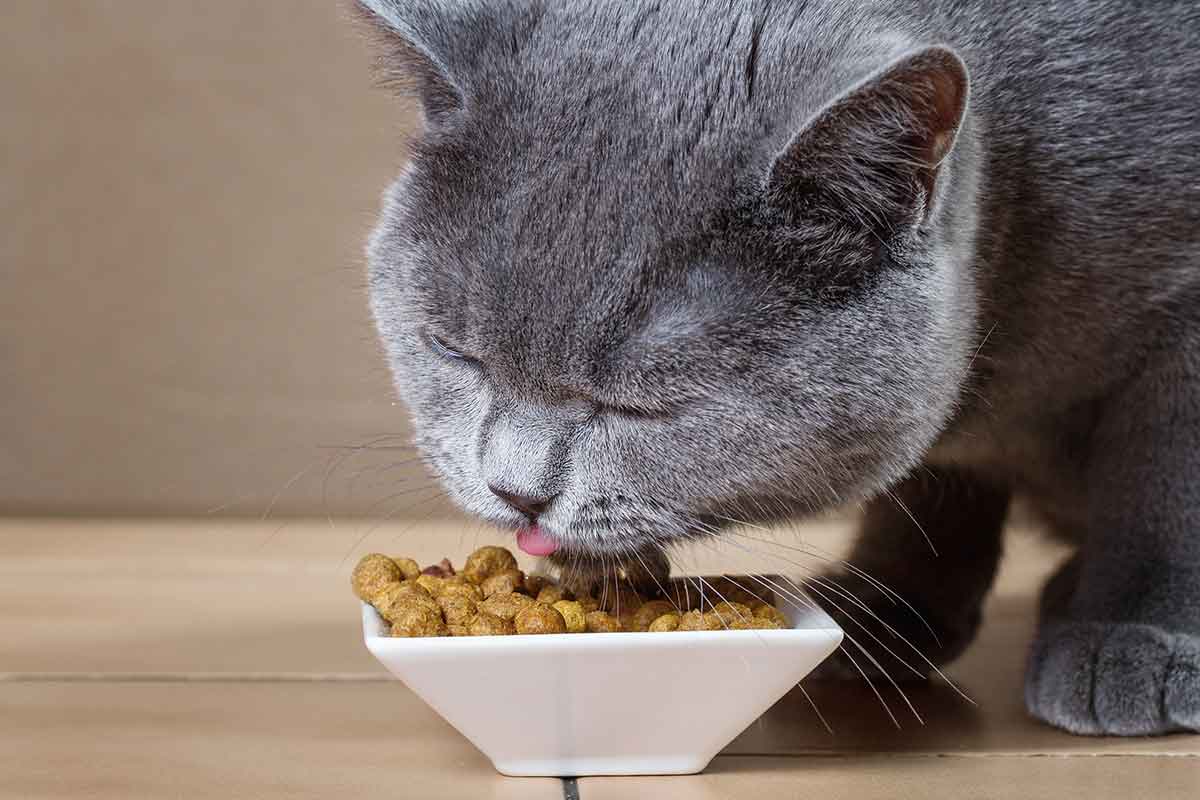My four-year-old Karma-Kat easily puts on weight, but is a model for picky eaters everywhere. In contrast, my 21-year-old Seren-Kitty weighs barely six pounds, eats everything, and wants to munch constantly. How does your cat fit in this spectrum? While there are exceptions to every rule, most cats follow in their ancestor’s pawprints. Blame how cats eat on feline evolution.
Cats Are Carnivores
Cats are obligate carnivores, which means they must obtain certain nutrients found only in meat protein. This distinction means feline teeth are designed for capturing and killing prey, and chopping it into mouth (or mouse) size morsels.
A successful feral cat will kill and eat about nine mice in a day, probably with a few failed hunts in between. Cats usually eat small animals whole. Larger prey like blackbirds or bunnies may be partially skinned or plucked, and then the choice parts consumed.
Cats Are Predators
Backward-curving cat claws also serve as snares that catch and hold struggling prey. Paws scoop and flip small prey into the air, disorienting the mouse or fish and thwarting its escape. Housecats employ many of the same hunting techniques when playing with toys. The cat bats at moving objects to prompt their continued motion, which in turn further stimulates feline predation. During play, cats or kittens may become so excited they forget to keep claws sheathed.
The cat who hunts clutches the captured victim in both paws, holds with claws, and quickly dispatches it with a practiced bite. Cats use a killing bite to the back of the neck, just at the point where the head joins the backbone. Their specialized canine teeth—the long, pointed, dagger-shaped ones—are designed to separate a mouse’s vertebrae and sever the spinal cord.
Addressing Cat Appetites
Cats do not have flattened molar teeth typical of people or dogs, used to crush and grind fruit and vegetables. Nope, they rely on the meat-shearing action of carnassial molars typical of carnivores.
Cats prefer meaty flavors. Chemical irritations and “mouth feel” influence how well cats like or dislike a flavor. That’s why cats may prefer one kibble shape over another that’s the exact same formulation.
Mouth feel can be influenced by changes in saliva content caused by dehydration that commonly develops in aged cats. Disease or medication can reduce or increase the sensitivity of the mouth and tongue, and alterations in taste (and smell). Warming foods increases the volatility of tastes and scents to make them more intense and appealing to the aging cat’s palate.
A cat’s appetite is so closely connected to smell that a stopped-up nose can cause life-threatening anorexia. The sense of smell signals to the cat that the item is edible.
Finicky Felines?
Cats quickly learn to avoid eating foods that make them feel bad. Studies have shown that when cats are fed diets deficient in thiamin, the cats refuse to eat that food within a few days. The thiamin deficiency causes a feeling of malaise, which if associated with the flavor of the food, causes the cat to avoid that food in the future.
Aversion to certain foods evolved as a way for wild felines to avoid toxins or insufficiencies in their diet. In one study, cats learned to avoid a diet that made them feel bad in only one meal and remembered that aversion up to 80 days later.
This built-in mechanism could be misinterpreted by pet cats. For instance, the cat suffering a bout of diarrhea due to intestinal worms could associate the illness with the most recent meal and avoid foods of that flavor in the future. This may be the reason that Kitty suddenly refuses a diet she’s accepted in the past or simply that cats prefer novel foods.
Feed Cats Naturally
Today, understanding how cats eat helps owners provide both nutritional and emotional needs. Partnering hunting movement stimulates the appetite of reluctant feeders, and reduces mealtime stress. Food formulations address the nutrients cats need, while measured feeding throughout the day allows cats to be the natural intermittent feeders they are meant to be.
This article was reviewed/edited by board-certified veterinary behaviorist Dr. Kenneth Martin and/or veterinary technician specialist in behavior Debbie Martin, LVT








